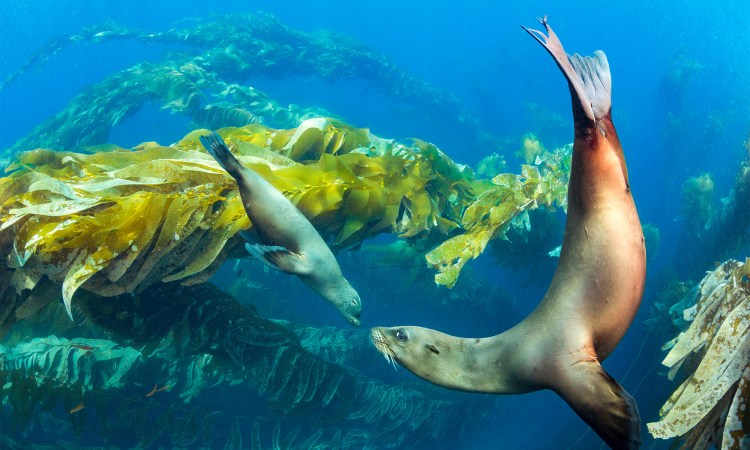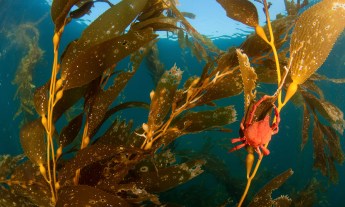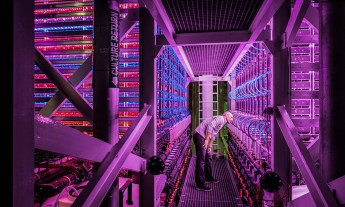
You’ve probably heard of all sorts of high-tech developments being used to address climate change, from wind turbines and solar panels to green hydrogen and electric vehicles. But it turns out some solutions already exist in the natural world, and seaweed — yes, seaweed — could be an unsung hero in the fight against climate change.
In fact, when I talk with someone who’s read my book, The 100% Solution: A Plan for Solving Climate Change, one of their first comments is often “one of the most interesting things I learned was about the seaweed.”
That’s because these unassuming marine plants are really powerful. By using seaweed to reduce cattle methane (5 to 10 percent of global emissions), replace plastics and other carbon-intensive materials (another 5 percent), and capture carbon (around 2 percent), it has the potential to cut nearly 15 percent of greenhouse gas emissions!
Here are five ways seaweed — one of the fastest-growing photosynthetic organisms out there — could help us solve climate change.
1. Reducing cow burps
You read that right. Because of their unique digestion systems, cows, sheep and goats burp (and fart) far more methane than other animals. This can really add up. Together, livestock is responsible for around 14.5 percent of global emissions. Methane is a powerful greenhouse gas with around 80 times the warming power of CO₂ in the first 20 years after it’s released, so it has a major influence on near-term warming, or the temperature rise over the next few decades.
Scientific trials have shown seaweed to consistently reduce cattle methane by a whopping 80% or more.
There are various dietary changes that dairy and beef farmers can make to lower methane from their livestock. One of the most promising is a seaweed called asparagopsis, which is grown in either the ocean or in tanks on land, freeze-dried and sprinkled onto cattle feed. Scientific trials have shown it to consistently reduce cattle methane by a whopping 80 percent or more.
Many companies are working to grow this seaweed at scale and encouraging farmers to adopt it, including Greener Grazing, Symbrosia, CH4 Global, Blue Ocean Barns, Volta, Sea Forest and the umbrella licensing company Future Feed.
2. Sequestering CO₂ from the atmosphere
To stop climate change impacts from getting worse, we don’t just need to reach net-zero greenhouse gas emissions, but we also need to remove the carbon in the atmosphere that has been emitted over the past century and a half. Seaweed could help. Several research teams are investigating carbon removal methods that involve growing kelp and other types of seaweed in the deep ocean where it won’t interfere with fragile, coastal ecosystems, a process that is also known as “ocean afforestation.” Seaweed absorbs CO₂ from the atmosphere while it’s growing, and that CO₂ will be locked away in the pressurized depths of the ocean once it dies and sinks to the ocean floor.
One paper estimated that all current annual emissions could be made up for if kelp forests covered 9% of the ocean.
It’s difficult to estimate how much CO₂ these approaches would really sequester, and another question is whether these enterprises could ever be affordable enough to do on a massive scale. There are also concerns that growing large-scale kelp forests could interfere with marine animals or shipping routes.
One 2012 paper estimated that all current annual emissions could be made up for if kelp forests covered nine percent of the ocean. While forests of this size likely aren’t realistic if even a fraction of that could be achieved, seaweed might be able to remove billions of metric tonnes of CO₂ from the atmosphere. Organizations like Running Tide and Climate Foundation are developing these ocean technologies.
3. Boosting fish production
In general, we know kelp forests are good for the ocean. They create healthy ecosystems where other organisms can flourish, and they can even clean toxins from agriculture and industrial runoff. Growing kelp forests — even on a much smaller scale than we’d need to sequester CO₂ — can create ecosystems where fish and other sea creatures thrive. Planting these new ecosystems in parts of the deeper ocean, which are currently less populated by marine life, could also increase the amount of fish that humans can sustainably harvest and live on.
What’s more, seafood could help feed the world’s growing population while simultaneously shifting human diets away from carbon-intensive meats. A recent World Resources Institute report on food and agriculture noted that sustainable fishing could fill a significant part of the gap between projected food supplies and the nutrition the world needs. Fishing is also far more efficient than meat in terms of land use and generates far lower amounts of greenhouse gas emissions. GreenWave is one company that’s exploring this type of regenerative ocean farming.
Today, plastic and many industrial chemicals are made from petroleum. Some companies are turning to seaweed as a potentially quick and easy-to-grow material for making bio-based products.
4. Fake meat
You’ve probably heard of plant-based “meats” like Beyond Burgers or Impossible Burgers as more and more companies attempt to produce meat substitutes that taste as good as or better than animal meat.
Several of these companies are relying on seaweed. In particular, certain red seaweeds can help fake meat look more like real meat, achieve a more realistic texture, and brown successfully as it cooks. Seaweed also provides a “meaty” depth of flavor and nutrients that make it a standout fake meat product. Companies like Trophic, NovaMeat and New Wave are producing plant-based meat substitutes and seaweed proteins, and AKUA makes a kelp burger.
5. Replacing petroleum and making other products
Today, plastic and many industrial chemicals are made from petroleum. Some companies are turning to seaweed as a potentially quick and easy-to-grow material for making bio-based products that can outperform oil. For example, seaweed-based plastics could displace petroleum-based plastics, and they’d use less energy to produce.
C-Combinator is one company that is trying to sell seaweed-based products, from cosmetics to carbon-neutral materials for steel manufacturing. Their approach is to harvest a portion of the brown seaweed sargassum, which is currently over-growing in the Atlantic Ocean due to fertilizer runoff and washing up on beaches, and transform this waste — some of which rots and produces methane — into high-value products and materials including gels and rubbers used in a variety of products.
Many companies are pursuing different uses for seaweed-based materials, including Notpla, EvoWare and local startups in Indonesia.
Want to know more about seaweed and the starring role it could play in the climate crisis? Watch this talk from explorer and professor Tim Flannery:



















